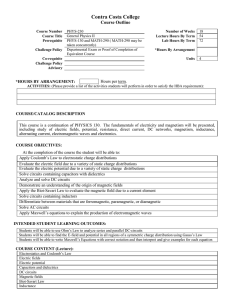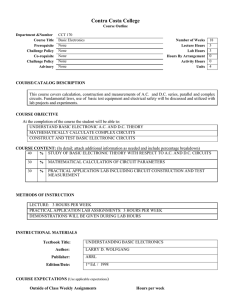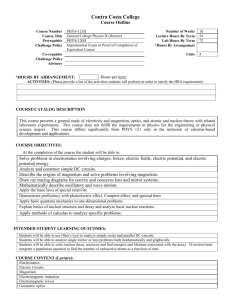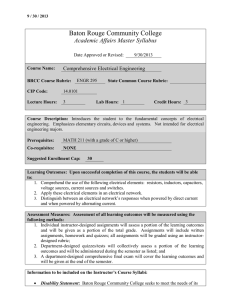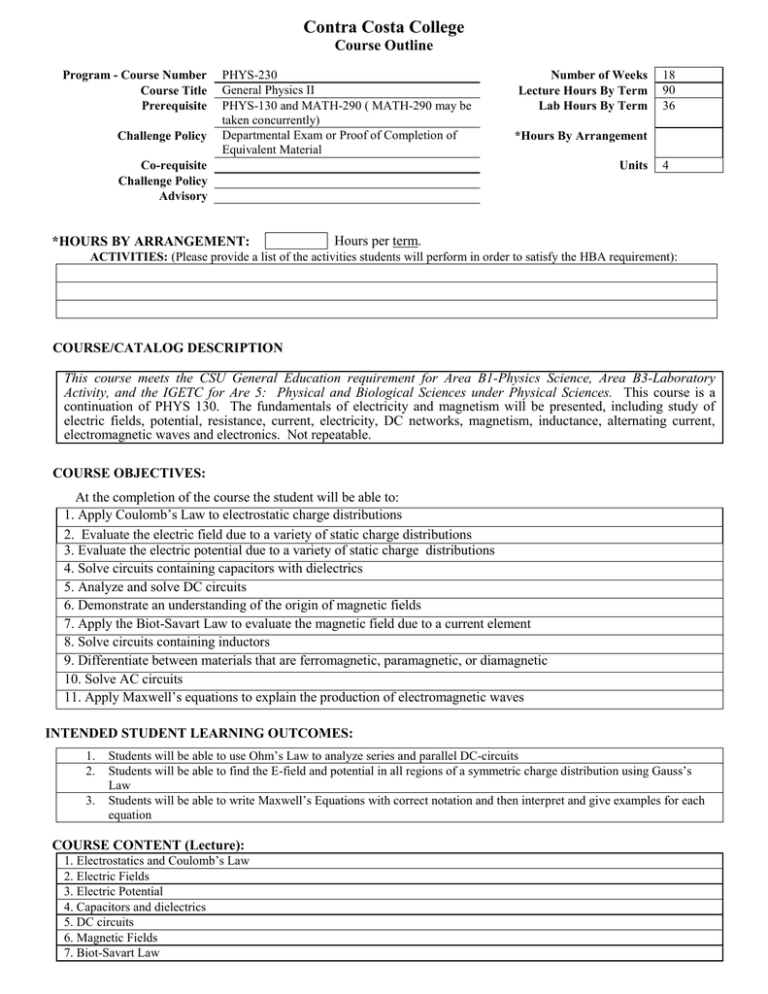
Contra Costa College
Course Outline
Program - Course Number
Course Title
Prerequisite
Challenge Policy
PHYS-230
General Physics II
PHYS-130 and MATH-290 ( MATH-290 may be
taken concurrently)
Departmental Exam or Proof of Completion of
Equivalent Material
Number of Weeks
Lecture Hours By Term
Lab Hours By Term
*Hours By Arrangement
Co-requisite
Challenge Policy
Advisory
*HOURS BY ARRANGEMENT:
18
90
36
Units
4
Hours per term.
ACTIVITIES: (Please provide a list of the activities students will perform in order to satisfy the HBA requirement):
COURSE/CATALOG DESCRIPTION
This course meets the CSU General Education requirement for Area B1-Physics Science, Area B3-Laboratory
Activity, and the IGETC for Are 5: Physical and Biological Sciences under Physical Sciences. This course is a
continuation of PHYS 130. The fundamentals of electricity and magnetism will be presented, including study of
electric fields, potential, resistance, current, electricity, DC networks, magnetism, inductance, alternating current,
electromagnetic waves and electronics. Not repeatable.
COURSE OBJECTIVES:
At the completion of the course the student will be able to:
1. Apply Coulomb’s Law to electrostatic charge distributions
2. Evaluate the electric field due to a variety of static charge distributions
3. Evaluate the electric potential due to a variety of static charge distributions
4. Solve circuits containing capacitors with dielectrics
5. Analyze and solve DC circuits
6. Demonstrate an understanding of the origin of magnetic fields
7. Apply the Biot-Savart Law to evaluate the magnetic field due to a current element
8. Solve circuits containing inductors
9. Differentiate between materials that are ferromagnetic, paramagnetic, or diamagnetic
10. Solve AC circuits
11. Apply Maxwell’s equations to explain the production of electromagnetic waves
INTENDED STUDENT LEARNING OUTCOMES:
1.
2.
3.
Students will be able to use Ohm’s Law to analyze series and parallel DC-circuits
Students will be able to find the E-field and potential in all regions of a symmetric charge distribution using Gauss’s
Law
Students will be able to write Maxwell’s Equations with correct notation and then interpret and give examples for each
equation
COURSE CONTENT (Lecture):
1. Electrostatics and Coulomb’s Law
2. Electric Fields
3. Electric Potential
4. Capacitors and dielectrics
5. DC circuits
6. Magnetic Fields
7. Biot-Savart Law
8. Inductance
9. Ferromagnetism, paramagnetism, and diamagnetism
10. AC circuits
11. Electromagnetic waves and Maxwell’s equations
COURSE CONTENT (Lab):
1. Electrostatics
2. Ohm’s Law I/Introduction to Meters
3. Electric Field Mapping
4. Ohm’s Law II/Resistors and Bulbs
5. Parallel Plate Capacitors
6. Capacitors/Series and Parallel
7. Magnetic Field Mapping
8. Tangent Galvanometer
9. RC Circuits
10. Faraday’s Law
11. RL Circuits
12. RLC Circuits
METHODS OF INSTRUCTION:
1. Lecture with demonstrations
2. Classroom discussions and activities
3. Problem Solving
4. Laboratory experiments using electronic equipment
5. Computer applications, including spreadsheets and computer-based digital sampling oscilloscopes
INSTRUCTIONAL MATERIALS:
NOTE: To be UC/CSU transferable, the text must be dated within the last 7 years OR a statement of justification for a text beyond the
last 7 years must be included.
Textbook Title:
Author:
Publisher:
Edition/Date:
Textbook Reading Level:
Justification Statement:
Lab Manual Title
Author:
Publisher:
Edition/Date:
Physics for Scientists and Engineers: A Strategic Approach
Randall D. Knight
Pearson Addison-Wesley
3rd Edition / Copyright 2013
(For textbook beyond 7 years)
Contra Costa College Physics 230 Lab Manual
Celesia, J., Wieber, D., Wong, M., et al
Contra Costa College Bookstore
Spring 2014
OUTSIDE OF CLASS WEEKLY ASSIGNMENTS:
Title 5, section 55002.5 establishes that a range of 48 -54hours of lecture, study, or lab work is required for one unit of credit.
For each hour of lecture, students should be required to spend an additional two hours of study outside of class to earn one
unit of credit.
State mandates that sample assignments must be included on the Course Outline of Record.
Outside of Class Weekly Assignments
Weekly Reading Assignments (Include detailed assignment below, if applicable)
Chapter 29, Potential and Field, pages 839- 862
Weekly Writing Assignments (Include detailed assignment below, if applicable)
Hours per week
3
Weekly Math Problems (Include detailed assignment below, if applicable)
7
7
Problems and Conceptual Exercises 5, 16, 18, 23, 24, 26, 30, 34, 47, 54 and 70
Lab or Software Application Assignments (Include detailed assignment below, if applicable)
Other Performance Assignments (Include detailed assignment below, if applicable)
STUDENT EVALUATION: (Show percentage breakdown for evaluation instruments)
Course must require use of critical thinking, college-level concepts & college-level learning skills.
For degree credit, course requires essay writing unless that requirement would be inappropriate to the course objectives. If writing
is inappropriate, there must be a requirement of problem-solving or skills demonstration.
% Essay (If essay is not included in assessment, explain below.)
65
15
20
%
%
%
%
%
%
Computation or Non-computational Problem Solving Skills
Skills Demonstration
Objective Examinations
Other (describe)
Lab assignments
Homework
GRADING POLICY: (Choose LG, P/NP, or SC)
Pass / No Pass
X Letter Grade
90% - 100% = A
80% - 89% = B
70% - 79% = C
60% - 69% = D
Below 60% = F
70% and above = Pass
Below 70% = No Pass
Student Choice
90% - 100% = A
80% - 89% = B
70% - 79% = C
60% - 69% = D
Below 60% = F
Percentages vary from instructor
to instructor
or
70% and above = Pass
Below 70% = No Pass
Prepared by: Jon Celesia and Mark Wong
Date: Spring 2014
Revised form 10/13

